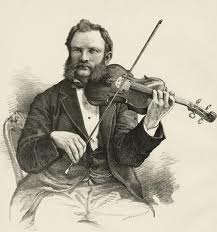Hello! Ask me (almost) anything about traditional music.
Annotation:Laird o' Drumblair Strathspey (The)
X:1 % T:Laird o' Drumblair, The M:C L:1/8 R:Strathspey N:(Play with) "Fire and force" C:J. Scott Skinner B:Harp and Claymore Collection (1904) B:The Scottish Violinist (1900) Z:AK/Fiddler's Companion K:A E | {G}[A2A2] c>A [AE]<A c>A | {A}a2 g>a f>ae>c | (3.d.e.f (3.e.f.g (3.a.e.d (3.c.B.A | (3.B.c.d (3.c.B.A (3.G.F.E (3.d.c.B | {G}[A2A2] c>A E<A c>A | {A}a2 g>a f>ae>c | (3.d.e.f (3.e.f.g (3.a.e.d (3.c.B.A | (3GFE (3dcB {G}[A2A2] A || g | {g}a2 e>a c>aA>a | (c/B/A) (e>g) a>A ca | {^a}b2 f>b d>fB>f | (d/cB f>)B {^a}b>B d<b | {g}a2 e<a c>>a A>>a | (c/B/A) e>g a>Ac>A | (3.d.e.f (3.e.f.g (3.a.e.d (3.c.B.A | (3GFE (3dcB {G}[A,2A2A2]-[A,EA]|| "Last"GFE DCB, (A,2 A,) || [E8A8]!fine!!fermata!||

LAIRD O' DRUMBLAIR STRATHSPEY, THE. Scottish, Strathspey or Schottische. A Major (Alburger, Bain, Brody, Cranford, Emmerson, Phillips, Skinner): G Major (McCutcheon). Standard or AEae (recommended by Skinner in 1904) tunings. AB (Alburger, Hardie, Hunter, Johnson, Skinner): AA'B (Emmerson): AABB (Bain, Brody, Cranford, Phillips): AA'BB' (Perlman). The mansion of Drumblair lies in the Parish of Forgue, on the north-western borders of Aberdeenshire in the North West of Scotland. The tune was composed by J. Scott Skinner (1843–1927) for his friend and benefactor William F. McHardy of Drumblair, who gave Skinner use of a rent-free cottage for many years to support his art. In his autobiography (My Life and Adventures, Wallace Music, 1994) Skinner wrote that McHardy, the Laird, was so impressed with the composition that for the remaining 15 years of his life he sent Skinner a thank-you check at Christmas-time. McHardy could apparently well afford to be magnanimous, for he had made a fortune of over 100,000 pounds in South America with engineering enterprises before returning to live at Forgue near Huntly. The tune is considered one of the finest and most famous of Skinner's 600 compositions, and appears in his Harp and Claymore collection. It was one of the tunes included by him later in his career in the romantically entitled 1921 concert set "Warblings From the Hills." Skinner, writing in his autobiography My Life and Adventures (first serialized in The People's Journal, 1923), described his inspiration for the tune: "Suddenly [one night] a tune, 'pat' and complete, flashed into my head in his honour. I jumped out of bed [looking for music manuscript paper]...but a search produced nothing better than a piece of soap paper, and on this I promptly dashed off 'The Laird o' Drumblair.' And the tune was dispatched as it had been written." "Ye're no' gaun tae send that awfy-like paper tae the Laird," protested his wife, "He'll jist licht his pipe wi' it!" It was sent anyway. Skinner also rendered the same melodic motif as a reel called "Angus Campbell."
Skinner recorded "Gladstone" in 1910 in London with pianist Ethel Stuart, one of a series of Skinner recordings from that session heard by a young Donegal fiddler John Doherty, and added to his own repertory [1].
- ↑ Thomas Caldwell, "Did you hear about the poor old travelling fiddler?’ - The Life and Music of John Doherty", Doctoral Thesis, 2013, pp. 90-91.


